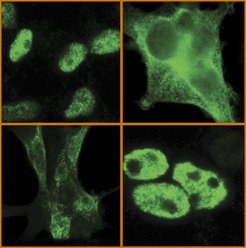uvCLAP
A new method to unlock the secrets of gene regulation at the RNA level
RNA-binding proteins (RBPs) influence the structure and interactions of RNA molecules and play a key role in various cellular processes and in regulating the patterns of gene expression. Researchers from the Max Planck Institute of Immunobiology and Epigenetics (MPI-IE) and the University of Freiburg have developed a new method called uvCLAP to identify binding sites of these small proteins on the RNA. The versatile and robust technique is performed without dangerous radioactive substances as well as expensive antibody reagents and is a time-saving approach to studying protein-RNA interactions.
Our genomic material resides in the nuclei of our cells as DNA and requires to be moved out of the nucleus and into the cytoplasm to express itself. To do this, DNA is first converted in a process called transcription into RNA, and through this intermediate molecule, our cells are able to produce proteins and enzymes.
RBPs regulate RNA birth and fate
RNA-binding proteins (RBPs) play key roles during this process: they bind to RNA in the nucleus and assist them into the cytoplasm. Moreover, RBPs can change the fate and function of the bound RNAs. Scientists refer to RBPs as the Swiss Army knife of post-translation modification because of their biological functions. It is known that different RNA-binding proteins can exert different effects. While some can promote the production of more proteins from the same RNA molecule, others can reduce the protein output, or even cut out parts of the RNA to make a particular protein. RBPs can also postpone protein synthesis until the RNA is parked at specific locations in the cell or help destroying the RNA before it even produces a protein.
New versatile method to identify binding sites of RBPs
Since there are more than a thousand RNA-binding proteins encoded in the human genome, determining which RNA-binding protein interacts with which RNAs is very important to understand how they influence gene expression in our cells. Researchers from the Max Planck Institute of Immunobiology and Epigenetics and the University of Freiburg have developed a new technique for precisely this purpose: To identify the binding sites of RNA-binding proteins.

The method called “Ultraviolet crosslinking and affinity purification” (uvCLAP) is fast, easy to execute and has been shown to work with human, mice or fruit fly cells. Unlike similar approaches, uvCLAP works without dangerous radioactive substances, lengthy protocols, and dependence on the availability of high-quality antibodies. By using highly stringent purification and straightforward multiplexing of experiments, the method enables the experimenter to remove contaminating free RNA and proteins and leads to substantial time savings by allowing the parallel processing of multiple samples.
With this new technique, researchers can look into many RNA-binding proteins simultaneously and study their expanded repertoire. Moreover, uvCLAP serves as a fast and convenient method to investigate regulatory relationships in the cell, where multiple RBPs compete or cooperate with each other for binding site selection.
Read more about the method by using the following link: The paper “uvCLAP is a fast and non-radioactive method to identify in vivo targets of RNA-binding proteins” published in Nature Communications is open access and can be freely accessed by anyone.
